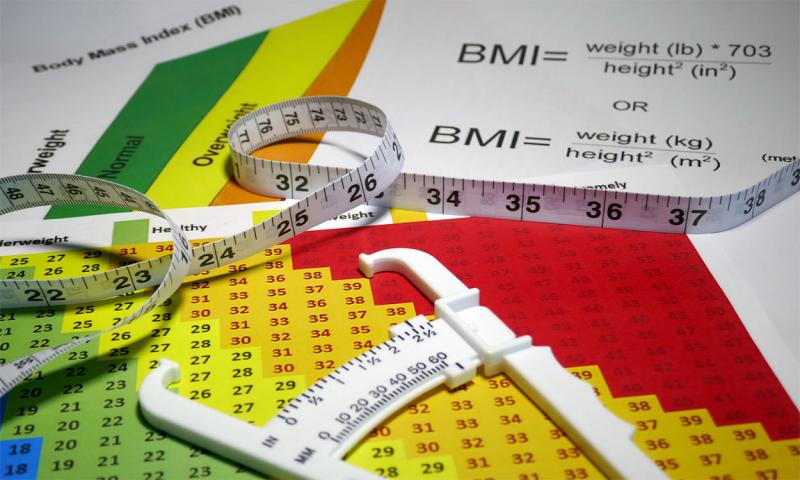What is body mass index and how is it different from body composition?

Written collaboratively by Hope Kleine, former SDSU Extension Health Education Field Specialist, and Alyssa Heyd.
We have all likely heard of measuring health through calculating body mass index (BMI), or perhaps you’ve heard the term during a visit to the doctor’s office. BMI is a ratio of your weight to height and a screening method used to determine a person’s weight category.
BMI is calculated by taking an individual’s weight in pounds (lbs.) divided by their height in inches (in.) squared, and then you multiply the figure by a conversion factor of 703:
- BMI = [Weight (lbs.) ÷ Height Squared (in.2)] × 703
For example, an individual who weighs 200 lbs. and is 5 feet and 9 in. tall:
- BMI = [200 lbs. ÷ (69 in. × 69 in.)] × 703
- BMI= [200 lbs. ÷ (4761 in.)] × 703
- BMI= 0.042 × 703
- BMI= 29.5
BMI is favored for the ease and affordability with which it can be measured. However, it is important to note that BMI measurements should be used along with other physical assessments to determine a more-accurate level of health and disease risk. While BMI provides insight into whether a person falls into a healthy weight range for their given height, it does not distinguish between muscle and fat mass.
Body composition is a breakdown of how much of an individual’s weight comes from muscle mass, fat mass and other anatomical components, such as bone mass. When compared with BMI, body composition offers a more-accurate insight into healthiness and disease risk.
Methods for Measuring Body Composition
Multiple methods exist for measuring body composition, each with advantages and disadvantages, including:
- Skinfold measurements involve the use of skinfold calipers to measure the thickness of subcutaneous fat at three to seven sites on the body, such as the abdomen or triceps. This method is affordable and time efficient, but measurement accuracy can be affected by the skill level of the individual completing the assessment.
- Bioelectrical Impedance Analysis (BIA) detects how your body responds to electrical currents by placing electrodes on the skin. Electrical currents move through muscle easier than fat due to the higher water content of muscle. This method is quick and easy, but accuracy varies widely and can be greatly affected by fluid and food intake and time of day during which the measurement is done.
- Hydrostatic Weighing, also known as underwater weighing, estimates your body composition based on its density while submerged under water. This method involves breathing out as much air as possible before submerging your body underwater. While accurate and relatively quick, hydrostatic weighing can be difficult or impossible for individuals who cannot stay submerged.
- Air Displacement Plethysmography (BodPod) looks at the relationship between the volume and pressure of air within a device to predict the density of your body. For this method you sit in an egg-shaped chamber for several minutes while the pressure of the air inside the chamber is altered. This method is accurate and relatively quick. However, it is quite costly and has limited availability.
- Dual-Energy X-Ray Absorptiometry (DXA) utilizes x-rays to provide detailed information on bone density, lean mass and fat in different regions of the body. This method is costly and is often not available to the general population.
Interpreting the Results
BMI is heavily influenced by body composition and body type. For example, an athlete with high muscle mass might fall into the overweight category on the BMI scale, but that does not mean they have a high fat mass percentage, as BMI measurements do not differentiate between muscle and fat mass. Similarly, an individual with a low BMI might still have a higher percentage of fat mass when body composition is measured.
Body type also plays a role in body composition. Factors such as age, race, gender, activity level and bone density should all be considered when evaluating an individual’s body composition results.
For body fat percentage ranges please see this publication courtesy of the American College of Sports Medicine.
| BMI | Weight Status |
|---|---|
| Below 18.5 | Underweight |
| 18.5 – 24.9 | Normal or Healthy Weight |
| 25.0 – 29.9 | Overweight |
| 30.0 and Above | Obese |
People with a BMI outside of the normal range may be at a greater health risk. Individuals who are considered underweight may not be getting adequate calories and nutrients to meet their daily needs, putting them at risk for certain health conditions. Individuals with an overweight or obese BMI can be more at risk for diabetes, high cholesterol or heart disease. If you have more questions on BMI or the different methods for measuring body composition, feel free to reach out to your physician, a certified exercise physiologist or registered dietitian nutritionist. BMI is just one part of your health and with simple lifestyle changes, one can improve their health.


